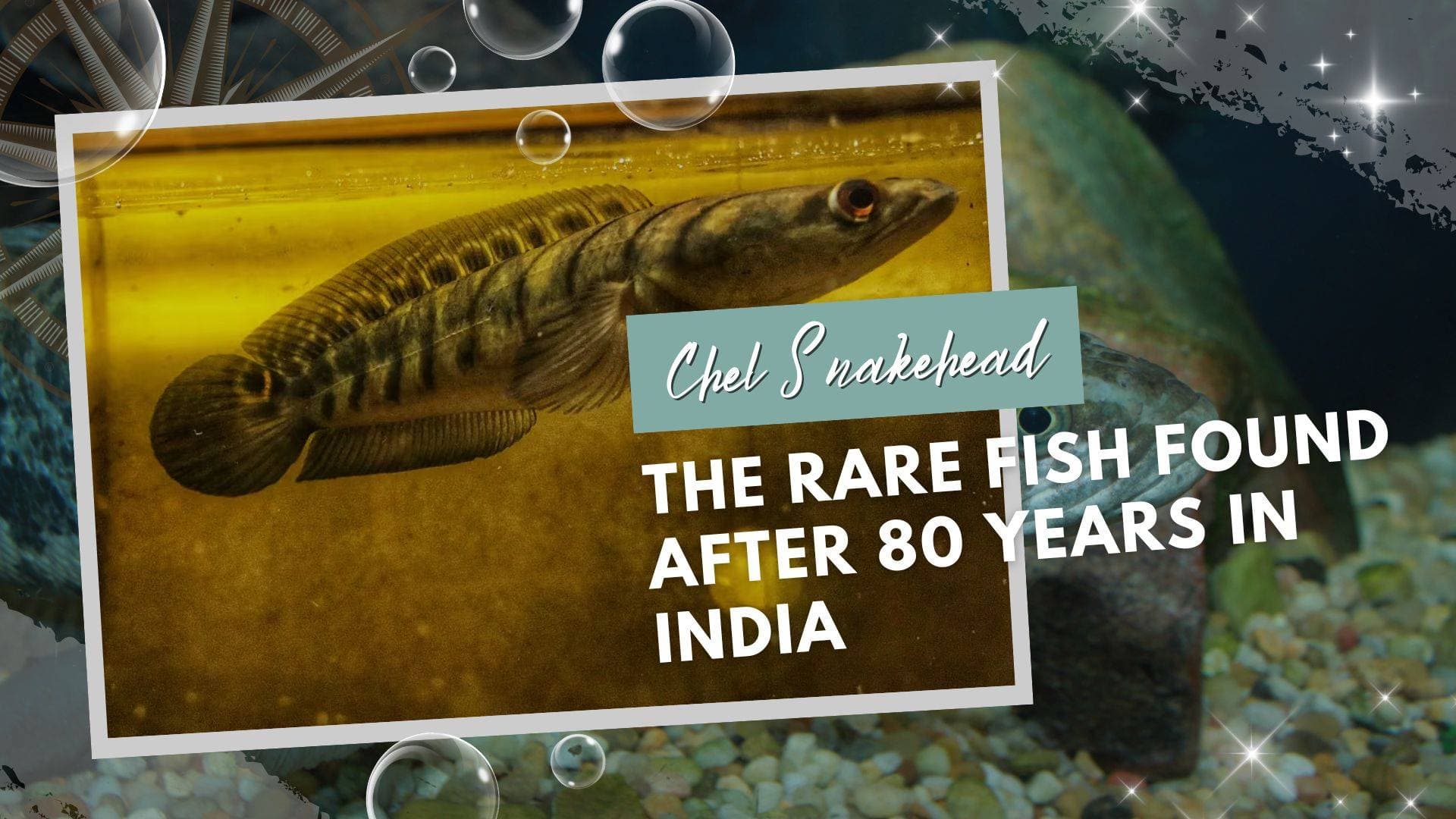Table of Contents
What Makes the Chel Snakehead So Rare
The 80-Year Mystery: Why Scientists Are Fascinated?
The Four Chel Snakeheads Left in the World
Inside the Tank: Behaviour and Diet
Chel Snakehead: The Rare Fish Found After 80 Years in India
Discover the rediscovery of the Chel Snakehead after 85 years. Learn about its unique habitat, historical challenges, and future conservation. Join the effort now!
A species once believed to have vanished has resurfaced, hidden deep within the icy streams of the Himalayan foothills. That creature is the Chel Snakehead (Channa amphibeus), rediscovered in 2024 after records dating back to 1918-1933 were found.
For decades, scientists searched northern India’s rivers for the long-lost Chel Snakehead, unseen for over 80 years since its last sighting in West Bengal. Its absence turned it into something of a myth among ichthyologists: a “living fossil” of freshwater fish, emblematic of species that slip silently into oblivion.
Then, in a dramatic twist, three live specimens were verified in the remote waters of the Chel River in the Kalimpong district of West Bengal. The news sent ripples through the scientific community: a fish once declared extinct was alive, hidden and surviving in its mountain world.
In this post, you'll discover what makes the Chel Snakehead so extraordinary and where you can see this once-lost Himalayan marvel up close.
Key Takeaways
- Rediscovered After 80 Years: Once thought extinct, the Chel Snakehead resurfaced in Arunachal Pradesh, marking one of India’s most remarkable freshwater discoveries.
- Only Four Known Worldwide: With one in Japan, two in Jamnagar, and one in Bengaluru, this species remains one of the rarest fish on the planet.
- A Living Fossil of the Himalayas: Adapted to cold, oxygen-poor mountain waters, it represents a rare evolutionary link in India’s freshwater biodiversity.
- Critical for Research & Conservation: The surviving specimens are key to genetic and behavioural studies that can guide future preservation efforts.
- See It Up Close: Aquarium Paradise in Bengaluru is home to the only Chel Snakehead in South India, offering visitors a once-in-a-lifetime glimpse of this ancient marvel.
What Makes the Chel Snakehead So Rare
The Chel Snakehead reads like a natural history mystery. Endemic to the cold Himalayan streams and unseen for most of the 20th century, this elusive fish was only recently confirmed in the wild again.
Its limited range, remarkable ability to survive in oxygen-poor waters, and century-long disappearance make it one of India’s most extraordinary freshwater discoveries.
Why it’s naturally scarce:
- A mountain specialist: The Chel Snakehead is native to high-altitude rivers and tributaries in the Eastern Himalayas (the Chel River/Kalimpong area). Such narrow endemism, being tied to a single river system, makes populations intrinsically small and vulnerable.
- Hidden habitat, hidden fish: Its home streams are remote, forested, and seasonally changeable. Limited access and sparse survey effort in these areas helped the species go undetected for decades. Modern surveys in 2024 finally documented multiple specimens.
Beyond where it’s found, how it’s built is equally remarkable.
Distinctive Physical Traits
Its striking physical traits make it instantly identifiable among freshwater species:
- Snake-like Head: The Chel Snakehead features the classic elongated body and flattened, tapering head typical of its family, giving it a serpent-like appearance.
- Unique Colours: What truly sets it apart are its vivid chrome-yellow to orange stripes and a glowing neon patch beneath the eye; markings that make it instantly recognisable to experts.
- Scale & lateral-line counts: Taxonomists note it has exceptionally high lateral-line scale counts for its group; a morphological fingerprint used to distinguish it from related snakeheads.
These unique traits don’t just make the animal stand out; they play a crucial role in how it survives in its harsh environment.
Survival Adaptations
Its remarkable survival instincts and environmental adaptations make the Chel Snakehead both resilient and exceptionally difficult to find in the wild.
- Low-oxygen tolerance & air-breathing: Like other Channidae, it possesses suprabranchial structures allowing atmospheric respiration; an adaptation for intermittent, low-oxygen waters. This allows individuals to survive in isolated pools and flooded fields, where they can remain hidden from surveyors.
Seasonal movements: Juveniles use floodplain habitats during rains; adults can shelter in forest pools and streambeds during dry periods. These seasonal shifts make population detection unpredictable.
Such rarity and secrecy lead us to the next question: why has it captivated scientists for so long?
The 80-Year Mystery: Why Scientists Are Fascinated?
The Chel Snakehead’s reappearance offers scientists a chance to study an ancient lineage that survived undetected in one of the world’s most remote freshwater ecosystems.
Verified specimens and live images now allow researchers to compare old museum samples, map their true distribution, and explore how such species endure in extreme Himalayan conditions.
“It’s like the aquatic world’s version of finding a dodo alive,” one researcher noted; a perfect reflection of the awe surrounding its return.
Why It Stayed Hidden for So Long?
The Chel Snakehead’s long disappearance wasn’t a mere coincidence; it was the result of its habitat, habits, and the challenges of the Himalayan terrain.
- Remote Habitat: Found only in steep, forested foothills of the eastern Himalayas, its cold, oxygen-poor rivers are rarely explored by researchers.
- Seasonal Movement: It migrates with the weather; juveniles spread into flooded plains during monsoons, while adults retreat into secluded forest pools in dry seasons.
- Local Sightings Overlooked: For years, locals caught and consumed the fish, unaware of their rarity, until researchers began connecting these reports.
- Environmental Pressures: Climate shifts, deforestation, and river pollution further reduced its numbers and visibility.
This combination of natural camouflage, shifting habitats, and minimal human study kept the Chel Snakehead hidden for nearly a century.
Its rediscovery didn’t just solve a mystery; it revealed an even greater one: only four living Chel Snakeheads are known to exist in the entire world.
The Four Chel Snakeheads Left in the World
Having re-emerged from near oblivion, the Chel Snakehead now exists in only a handful of known captive homes; a fact that adds both urgency and intrigue to its story.
Four specimens are publicly documented worldwide, each playing a vital role in research, conservation, and raising awareness about this extraordinary fish.
- Japan (one specimen): Reports in aquarium and conservation circles indicate that one Chel Snakehead is held in Japan, though detailed public documentation about the institution remains limited. That sole individual underscores the global rarity of the species.
- Vantara, Jamnagar, India (two specimens): The wildlife-conservation centre in Jamnagar, Gujarat, known as Vantara, maintains two Chel Snakeheads as part of its broader rescue, rehabilitation, and conservation operations. Their presence in India outside the wild offers an essential opportunity for captive observation.
- Bengaluru, India (one specimen): The only other documented individual is held in Bengaluru. This makes it the sole Chel Snakehead in captivity in South India, linking the Himalayas to a far-flung home hundreds of kilometres away.
Why These Four Matter
Beyond their rarity, the four surviving Chel Snakeheads are helping researchers uncover new chapters in freshwater evolution and conservation.
| Focus | What It Reveals | Why It Matters | Impact |
|---|---|---|---|
| Genetics | DNA mapping from live specimens | Clarifies its place in the snakehead family | Builds a genetic blueprint for future study |
| Conservation | Limited individuals in captivity | Supports potential breeding efforts | Helps secure the species’ survival |
| Behaviour Study | Observing air-breathing and movements | Offers insight into Himalayan adaptations | Guides habitat preservation |
| Public Awareness | Displayed in aquariums | Connects people to freshwater biodiversity | Inspires interest in conservation |
With only four Chel Snakeheads known to exist, understanding how they live has never been more critical. Their behaviour and feeding patterns reveal how this ancient species continues to adapt and survive against all odds.
Inside the Tank: Behaviour and Diet
The Chel Snakehead is a solitary, ambush-style predator equipped with adaptations that help it survive in fluctuating water conditions and low oxygen levels. In captivity, it shows the same basic habits as other Channa species: secretive daytime behaviour, bursts of predatory activity, and reliance on both aquatic prey and occasional surface air.
1. Behaviour
Observing the Chel Snakehead in captivity reveals instincts shaped by its wild Himalayan origins.
- Solitary and Territorial: It prefers living alone, hiding among rocks, roots, or dense plants. Each fish defends its own territory.
- Ambush Hunter: Rather than chase, it waits patiently and strikes swiftly when prey swims close.
- Air Breather: It surfaces often to gulp air using its special breathing organ. Tanks must allow easy surface access.
- Seasonal Instincts: Activity peaks during warmer, wetter months and declines when conditions mimic those of dry-season streams.
2. Diet
Its diet reflects a mountain predator’s appetite: simple, protein-rich, and built for survival.
- Strictly Carnivorous: It feeds on smaller fish, frogs, and crustaceans; a true meat-eater by nature.
- Juvenile vs Adult Diet: Young ones prefer small invertebrates, while adults need larger prey or meaty frozen food.
- Feeding Routine: Juveniles eat small meals daily. Adults can be fed two to three times a week.
What We Still Don’t Know
Breeding habits, wild diet details, and long-term behaviour are still being studied from the few living specimens available.
As researchers study how this species adapts in captivity, its survival offers valuable insights into conserving India’s fragile freshwater ecosystems.
A Symbol of Conservation
Most fish play their part quietly, but the Chel Snakehead is a silent regulator, shaping the health of its ecosystem in ways we rarely notice. By understanding its feeding habits, breeding instincts, and its natural role in the food chain, we can comprehend how this species contributes to the thriving of freshwater systems.
Here’s how the Chel Snakehead contributes to its environment:
- Top predator balance: As an apex predator in its native streams, the Chel Snakehead regulates populations of smaller fish, insects, and amphibians. This prevents overpopulation and maintains the balance of the food web.
- Ecosystem stability: By controlling prey density, it indirectly supports vegetation growth and nutrient cycling within forest-stream ecosystems.
- Biodiversity support: Its presence indicates a functioning ecosystem capable of supporting multiple trophic levels, from microorganisms to larger predators.
- Indicator species: Found only in clean, oxygen-rich, cold waters; its existence signals minimal pollution and stable water chemistry.
- Habitat connectivity: Seasonal movements between flooded fields and forest pools help disperse nutrients and sustain smaller aquatic species.
- Climate resilience marker: Studying its physiology helps scientists understand how cold-water fish adapt to shifting temperatures, aiding broader climate adaptation models for freshwater life.
Also discover the fascinating Indian Gar Fish: its habitat, feeding habits, unique adaptations, and ongoing conservation efforts.
It’s one thing to read about the Chel Snakehead’s impact, but it’s another to see the very fish redefining what survival means.
Where You Can See the Chel Snakehead
At Aquarium Paradise in Bengaluru, this rare Himalayan predator resides in a habitat meticulously designed to reflect its cold-stream origins. You’ll observe the Chel Snakehead’s sleek, serpent-like body and subtle camouflage in conditions tailored to its survival instincts.
Not only will you witness its air-breathing behaviour and ambush-hunting style, but you’ll also be within one of only four known captive enclosures of this species worldwide. This creates a truly unique opportunity: you’re not just visiting an aquarium, you’re meeting a living relic!
However, the Chel Snakehead is just one of the highlights. Aquarium Paradise features over 65 freshwater and saltwater species, combining science and spectacle in one immersive visit.
Other attractions to explore include:
- Underwater Tunnel: Walk through India’s longest 180-foot glass corridor, surrounded by sharks, rays, and schools of fish.
- Mermaid Show: Live underwater performances on Wednesday, Saturday & Sunday that add a touch of fantasy and fun.
- Jellyfish Room: A glowing, dream-like chamber filled with pulsating jellyfish displays.
- Ocean Window Lounge: Dine with panoramic views into massive tanks — perfect for families and couples.
- Interactive Feeding Sessions: Participate in feeding talks where staff explain the habits of species like eels, stingrays, and the Chel Snakehead.
Also Read: Aquarium Paradise: Visiting Hours and Schedule Information
Conclusion
The Chel Snakehead is living proof of nature’s ability to surprise us, even after decades of silence. From vanishing into Himalayan streams to reappearing in carefully curated tanks, its story captures the delicate balance between extinction and endurance.
At Aquarium Paradise, you can witness this once-lost predator up close, gliding with quiet power in a recreated mountain-stream habitat. It’s an experience that blends curiosity, conservation, and wonder; a chance to stand face-to-face with a species thought to have disappeared forever.
Beyond the Chel Snakehead, the aquarium opens a window into an entire aquatic universe, from shimmering arowanas to ethereal jellyfish, each tank a reminder of how much life our waters hold.
Book your tickets online to skip the queues and avail exclusive offers for an effortless visit to one of India’s most captivating underwater experiences.
FAQs
1. How many Chel Snakeheads exist today?
There are only four known living Chel Snakeheads in the world: one in Japan, two in Jamnagar, and one in Bengaluru. Their rarity makes them among the most exclusive freshwater specimens ever documented.
2. Why did scientists think the Chel Snakehead was extinct?
For over eight decades, there were no recorded sightings, as its habitat is deep within remote Himalayan streams. The rediscovery in Arunachal Pradesh stunned researchers who had long believed the species was lost.
3. What makes the Chel Snakehead special?
It’s a “living fossil” that evolved to survive in cold, oxygen-poor waters where most fish can’t. Its vibrant chrome-yellow stripes and ancient lineage make it both scientifically priceless and visually striking.
4. Can the Chel Snakehead survive outside the Himalayas?
Yes, when kept in precisely controlled environments that mimic its native water temperature and oxygen levels. This is why the few in captivity are maintained by expert aquarists with specialised care systems.
5. Where can I see the Chel Snakehead in person?
You can witness this rare Himalayan marvel at Aquarium Paradise in Bengaluru, the only public aquarium in South India to house a Chel Snakehead. Its carefully recreated habitat offers visitors a one-of-a-kind chance to see a species once thought extinct, up close and alive.
More To Read

6.17.2025
Top 10 Largest Crab Species Worldwide
Compare the largest crab in the world like the Japanese Spider and Coconut Crab. Explore traits, habitats, and conservation efforts. Click to know more!

5.22.2025
Explore the Mesmerizing Aqua Tunnel in Bengaluru
Discover Bengaluru's Aqua Tunnel, a top tourist spot with stunning aquatic displays and interactive experiences. Plan your visit today!

5.16.2025
Mesmerising Little Mermaid Shows Near You
Discover the magic of Aquarium Paradise in Bangalore with its unique underwater tunnel, mermaid show, and interactive marine experiences. Get more info here.

9.4.2025
10 Fun Places in Bangalore Where Kids Can Play, Learn & Explore
Find the best kids fun places near you in Bangalore! Explore activities that blend play, learning, and family time for a perfect day out.

